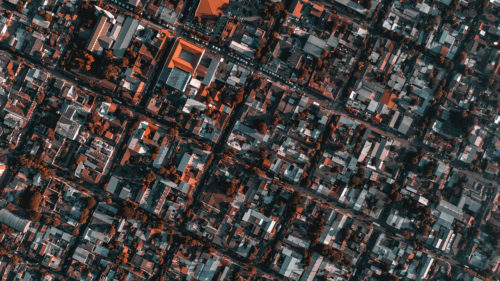
The Aimsun Next Web Map Service (WMS) Importer
June 2021: Geline Canayon guides you through adding a Web Map Service (WMS) or Web Map Tile Service (WMTS) server link to add background aerial images to your model.
The aim of this technical note is to show how the dynamic signal control system, Siemens UTC System with SCOOT (hereafter called ‘SCOOT’), connects with Aimsun Next. In doing so, it provides a link that enables the SCOOT algorithm to be incorporated into a simulation and for signals to be set in response to conditions in the traffic network.
The effect in the simulation is that signals change at the same times, or in response to traffic conditions, as they do on the road.
Please note the following important requirements:
The following step-by-step guide (12 steps) explains how to connect a junction in Aimsun Next to SCOOT in a Windows OS environment.

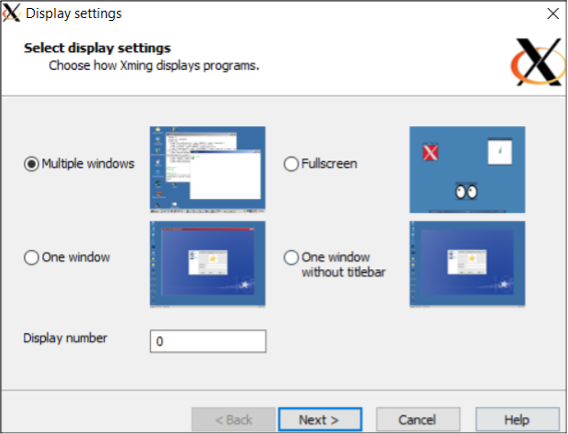


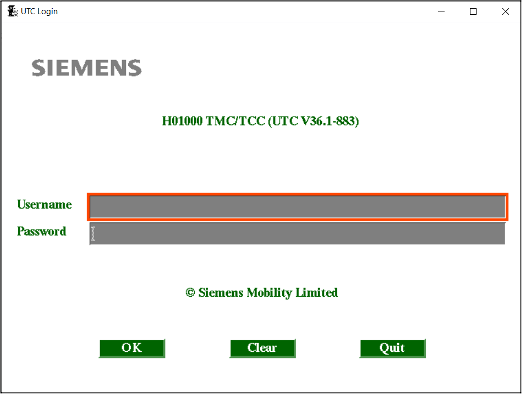
The following dialogs will be displayed.

In our example we will connect specific SCOOT junctions to an ‘external’ application (Aimsun Next) and view messages while the simulation is running. To do this, we need to set the junction sites on the SCOOT control.
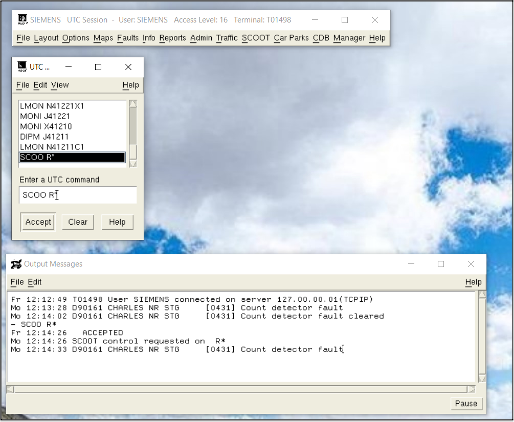

By this stage, SCOOT should be up and running and ready to connect with Aimsun Next.
Successful connection between SCOOT and Aimsun Next depends on the following exchange of information:
· From SCOOT to Aimsun: Stage information
· From Aimsun Next to SCOOT: Detector information (Presence and Occupancy parameters must be selected).
To guarantee a connection between SCOOT and Aimsun Next, SCOOT objects must have a one-to-one correspondence with Aimsun objects. This means that an adaptive signal-control system requires an Aimsun Next controller object at each junction to manage the link between the external system and the Aimsun Next network.
You can use Aimsun Next controllers to create and edit the links between junctions, their associated signal stages, and traffic detectors with their corresponding objects in the SCOOT system.
An exchange of information between SCOOT and Aimsun Next (synchronisation tokens, detector measures, and stages) takes place every second, as required by SCOOT. The detection cycle (Dynamic Scenario > Outputs to Generate tab) should therefore be set to 1 second.
To enable the connection with SCOOT:
1. Open the ANG file in Aimsun Next.
2. Identify which SCOOT junctions are included in the study area and locate those in the Aimsun Next network. In most cases, the SCOOT junction location and ID are provided by the traffic management center (TMC) or the City Authorization of the area. Usually, SCOOT junctions are marked on a map (PDF file or image file).We will use a SCOOT junction with the ID N41211 to demonstrate the step-by-step workflow required to connect SCOOT to Aimsun Next.
3. Open the relevant node in the network and set the External ID as N41211.
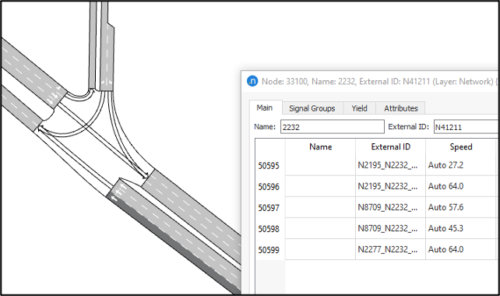
4. Set the signal groups in the node object.
a. First, open the SCOOT specifications (PDF from TMC or an external source). Scroll down, until you find the ‘Phase Type and Conditions’ section and use the ‘Title’ information to identify the signal group movements of each junction. For example, ‘Phase’ A, ‘Title’ A6 Leicester RD – TO CITY (INB) means that Phase A (which is movement A in Aimsun terms) is assigned to the A6 Leicester Road heading toward the city center.
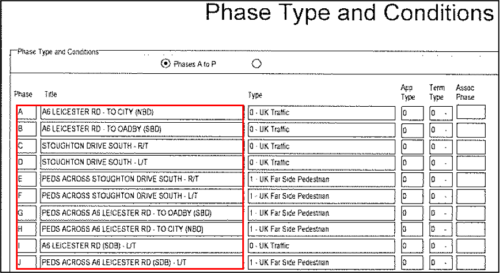
b. Click the Signal Groups tab and map the SCOOT phases (A–J in the screenshot above) to Aimsun Next signal group names (A–J in the screenshot below).

5. Set the signal phases in the relevant Aimsun Next control plan.
a. In the same SCOOT specification document, find the ‘Phases in Stages’ section. This is the SCOOT phasing/staging information that is required to assign the signal groups into phases in Aimsun Next’s control plan object.
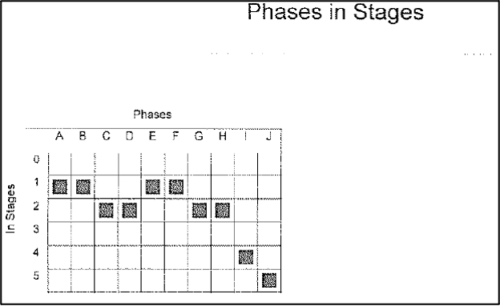
In the example above:
b. Open the control plan and complete the following steps:
i. Set the Control Type to External.
ii. On the Timing subtab, add phases and interphases.
iii. Assign signal groups to the corresponding phases. The durations of phase and interphase should be set to reflect the real-world backup control plan. This is so that, if the connection between SCOOT and Aimsun Next is lost, the real-world backup control plan will be activated.
iv. Create a new master control plan and include the recently created SCOOT external control plan.

6. From SCOOT, export the SCOOT detector information and then import (manually or by using Python scripts the SCOOT detector loop data into Aimsun Next. In the following example, the detector data was exported from the SCOOT Database in CSV format.

In the first column there are three SCOOT detectors associated with junction N41211: 41211A1, 41211B1, and 41211C1.
7. Check the SCOOT specifications to see whether any SCOOT stages are demand-dependent (meaning stages that are actuated only when there is demand present). If any demand-dependent stages are found, you should install a stage detector in the corresponding turn related to that stage.
In the following example, the ‘UTC Demand Dependent Forces’ section of the SCOOT specifications contains information about demand-dependent stages. Based on the screenshot below, Stage 2 (which is sometimes also described as Stage B in the SCOOT documents) with phases C, D, G, and H is demand-dependent.
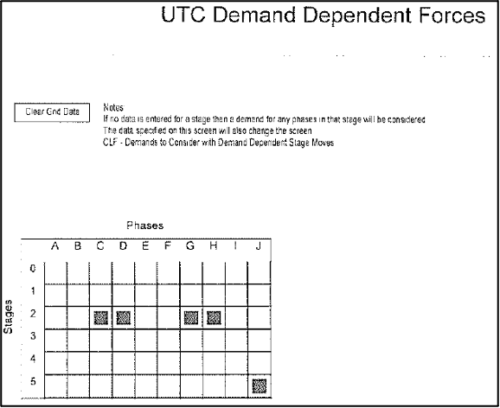
8. Sometimes, SCOOT loop drawings (PDF) are available. You can use these to better position the SCOOT and stage detectors in the Aimsun Next network. In our example, the following drawing helped us to locate SCOOT detectors 41211A1 (outbound from the city center) and 41211C1 (inbound to the city center).

9. Add four new detectors to the Aimsun Next network position them as indicated in the screenshot below.
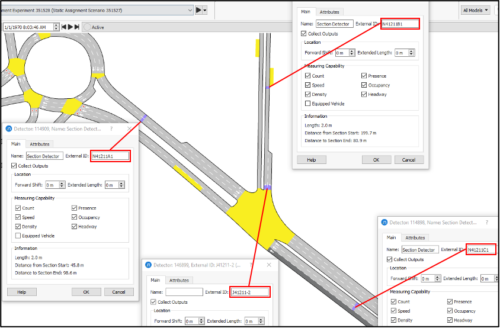
10. Enter External IDs for each detector, as illustrated:
A file named microsim_config.cnf is required to serve as an interface between Aimsun Next objects and SCOOT objects. The file maps SCOOT junctions, detectors, and stage detector IDs to the corresponding objects in the Aimsun Next controller.
For this to work, it is essential that you have set the same external IDs for the junction and its detectors in both Aimsun Next and SCOOT, as explained in the previous steps.
To create the cnf file:
a. Open a new text document.
b. Rename the file cnf.
c. Add the SCOOT junction (J41211), detectors (N41211A1, N41211B1, N41211C1), and the stage detector (J41211-2) to the file.
d. Send this file to the SCOOT expert so they can process it and generate new IDs for these objects.
e. The expert will produce a new version of the file cnf, with the new IDs (201, 420, 625, 626, 627) alongside the previous junction and detector IDs.
f. Save the cnf file in this location:
C:\ProgramData\Siemens Mobility Limited\UTC\movable\sys\current\tcca.
The file format for junctions, stage detectors, and stage detectors is as follows:
In our example, the contents of the microsim_config.cnf file will therefore be:
11. Add a new controller to the Aimsun Next network and set the following parameters:
Port and IP values must match those in SCOOT. If in doubt, check with your SCOOT expert.

12. Click the Detectors tab and set the following IDs in the ID column: 625, 626, 627, 420. Also, set the Type of detector to either SCOOT or Stage.

13. Click the Stages tab and map the SCOOT stage IDs (found in the SCOOT specifications ‘Phases in Stages’ section) with the Aimsun phase IDs (found in the control plan object) as illustrated below.

14. Open the dynamic scenario and for Master Control Plan, select the SCOOT plan.
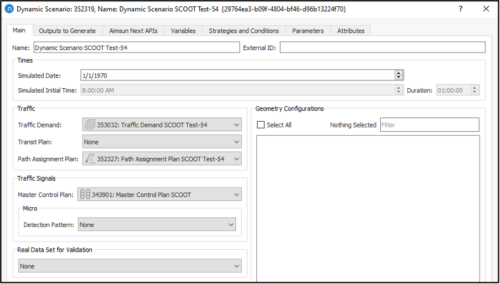
15. Run the replication associated with the scenario and experiment, and check for the following messages in the Log window:
“Initializing CORBA: …”
“Connected to Siemens UTC System.”
16. To verify that the current active phase in Aimsun Next is the one that SCOOT sends to Aimsun Next, double-click on the relevant node in the network and click the Simulation Control tab while the simulation is running. Watch the subsequent actuation of the phases in the control plan.
17. Switch to the DIPM window by entering the command DIPM J41211 in the SCOOT application.
The screenshot below shows that 22 seconds ago SCOOT sent an order to activate state A to Aimsun Next. In Aimsun Next, phase 1 has been active for 21.6 seconds, as indicated in the Simulation Control tab. This means that the connection is working correctly.
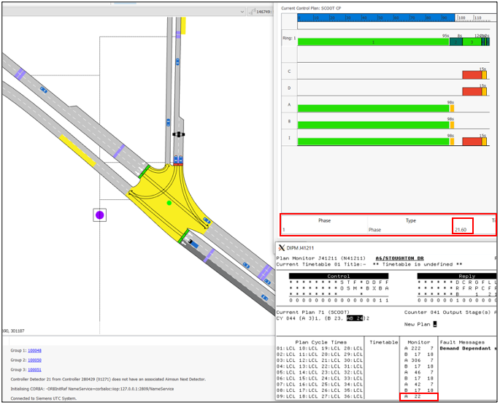
18. To live changes to the status of a detector (in this example N41211B), enter the command LMON N41211B1 in SCOOTS to open the LMON window for the specific detector. Each digit – either 0 or 1 – corresponds to a no-presence (=0) or presence (=1) measurement, with a frequency of 0.25 seconds. In the following example where 111 is highlighted, the vehicle that just crossed detector N41211B1 was measured as being present for 0.75 seconds.

Several vehicles have crossed detector N41211B1. Also, most of the vehicles have already crossed the stage detector J41211-2. Because stage B (SCOOT) and phase 3 (Aimsun Next) are demand-dependent, we expect it to be actuated in a few seconds based on the SCOOT logic. You can see the activation in both SCOOT and Aimsun Next applications.
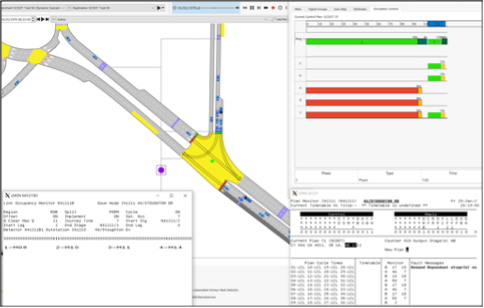
Tip: The SCOOT interface can be configured to produce debugging information. You can select this option in the dynamic scenario. Open the scenario and click the Output to Generate tab > Controllers tab and tick the option Generate Debug Files. When this option is selected, Aimsun Next will generate log files which are stored in the same folder as the ANG file.

June 2021: Geline Canayon guides you through adding a Web Map Service (WMS) or Web Map Tile Service (WMTS) server link to add background aerial images to your model.

June 2019: In Part 2 of this GIS pro tip, Geline Canayon explains network importer settings for GIS files.
SHARE
Aimsun Next 24
Aimsun (2024). Aimsun Next 24 User’s Manual, Aimsun Next Version 24.0.0, Barcelona, Spain. Accessed on: April. 16, 2024. [Online].
Available: https://docs.aimsun.com/next/24.0.0/
Aimsun Next 24
@manual {AimsunManual,
title = {Aimsun Next 24 User’s Manual},
author = {Aimsun},
edition = {Aimsun Next 24.0.0},
address = {Barcelona, Spain},
year = {2024. [Online]},
month = {Accessed on: Month, Day, Year},
url = {https://docs.aimsun.com/next/24.0.0},
}
Aimsun Next 24
TY – COMP
T1 – Aimsun Next 24 User’s Manual
A1 – Aimsun
ET – Aimsun Next Version 24.0.0
Y1 – 2024
Y2 – Accessed on: Month, Day, Year
CY – Barcelona, Spain
PB – Aimsun
UR – [In software]. Available:
https://docs.aimsun.com/next/24.0.0/